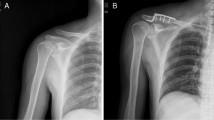Abstract
Purpose
To evaluate postoperative functional results in soccer players diagnosed with acute grade III acromioclavicular dislocation, stabilized with clavicular hook plate.
Methods
Between 2006 and 2010, 11 soccer players were diagnosed with acute acromioclavicular dislocation. Mean age was 22.9 years. The clavicular hook plate was used for stabilization. The follow-up was 4 years (2–6 years).
Results
Constant score showed 82 % excellent results and 18 % good functional results. Average pain measured with VAS was 1.8 (±0.59) mm out of 10. We did not report any complication within the process.
Conclusions
Use of the clavicular hook plate is considered adequate for the treatment of acute acromioclavicular dislocation in soccer players, allowing a quick return to sports.
Level of evidence
Retrospective case series, Level IV.
Similar content being viewed by others
References
Allman FL Jr (1967) Fractures and ligamentous injuries of the clavicle and its articulation. J Bone Jt Surg Am 49:774–784
Boileau P, Old J, Gastaud O, Brassart N, Roussanne Y (2010) All-arthroscopic Weaver–Dunn–Chuinard procedure with double-button fixation for chronic acromioclavicular joint dislocation. Arthroscopy 26(2):149–160
Cardone D, Brown JN, Roberts SN, Saies AD, Hayes MG (2002) Grade III acromioclavicular joint injury in Australian Rules Football. J Sci Med Sport 5(2):143–148
Cave EF (1958) Shoulder girdle injuries. In: Cave EF (ed) Fractures and other injuries. Year Book Medical, Chicago, pp 258–259
Chandrasenan J, Badhe S, Cresswell T, DeBeer J (2007) The clavicular hookplate consequences in three cases. Eur J Trauma Emerg Surg 3(5):557–559
De Baets T, Truijen J, Driesen R, Pittevils T (2004) The treatment of acromioclavicular joint dislocation Tossy grade III with a clavicle hook plate. Acta Orthop Belg 70:51–59
Faldini C, Nanni M, Leonetti D, Acri F, Galante C, Luciani D, Giannini S (2010) Nonoperative treatment of closed displaced midshaft clavicle fractures. J Orthop Traumatol 11(4):229–236
Galpin RD, Hawkins RJ, Grainger RW (1985) A comparative analysis of separation versus nonoperative treatment of grade III acromio-clavicular separations. Clin Orthop Relat Res 193:150–155
Henkel TH, Oetiker R, Hackenbruch W (1997) Die Behandlung der frischen AC-luxation Tossy III durch Bandnaht und temporare Fixation mit Klavikula-Hakenplatte. Swiss Surg 3:160–166
Larsen E, Bjerg-Nielsen A, Cristensen P (1986) Conservative or surgical treatment of acromioclavicular dislocation. J Bone Jt Surg Am 68:552–555
Lizaur A, Sanz-Reig J, Gonzalez-Parreño S (2011) Long-term results of the surgical treatment of type III acromioclavicular dislocations: an update of a previous report. J Bone Jt Surg Br 93(8):1088–1092
Madsen B (1963) Osteolysis of the acromial end of the clavicle following trauma. Br J Radiol 36:822–828
Mazzocca AD, Arciero RA, Bicos J (2007) Evaluation and treatment of acromioclavicular joint injuries. Am J Sports Med 35(2):316–329
Rockwood CA Jr, Williams GR, Young DC (1996) Injuries of the acromioclavicular joint. In: Rockwood CA Jr et al (eds) Rockwood and Green’s fractures in adults, 4th edn. Lippincott-Raven, Philadelphia, pp 1341–1431
Rockwood CA Jr, Williams GR, Young DC (1998) Disorders of the acromioclavicular joint. In: Rockwood CA, Masten FA II (eds) The shoulder. Saunders, Philadelphia, pp 483–553
Salzmann GM, Walz L, Buchmann S, Glabgly P, Venjakob A, Imhoff AB (2010) Arthroscopically assisted 2-bundle anatomical reduction of acute acromioclavicular joint separations. Am J Sports Med 38(6):1179–1187
Smith TO, Chester R, Pearse EO, Hing CB (2011) Operative versus non-operative management following Rockwood grade III acromioclavicular separation: a meta-analysis of the current evidence base. J Orthop Traumatol 12(1):19–27
Spencer EE (2006) Treatment of grade III acromioclavicular joint injuries. Clin Orthop Relat Res 455:38–44
Tossy JD, Mead NC, Sigmond HM (1963) Acromioclavicular separation: useful and practical classification for treatment. Clin Orthop Relat Res 28:111–119
Conflict of interest
No financial support, public or private, has been or will be received for the presented study.
Author information
Authors and Affiliations
Corresponding author
Rights and permissions
About this article
Cite this article
Pereira-Graterol, E., Álvarez-Díaz, P., Seijas, R. et al. Treatment and evolution of grade III acromioclavicular dislocations in soccer players. Knee Surg Sports Traumatol Arthrosc 21, 1633–1635 (2013). https://doi.org/10.1007/s00167-012-2186-0
Received:
Accepted:
Published:
Issue Date:
DOI: https://doi.org/10.1007/s00167-012-2186-0




